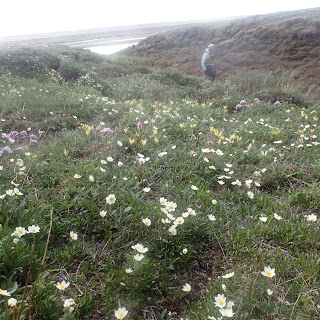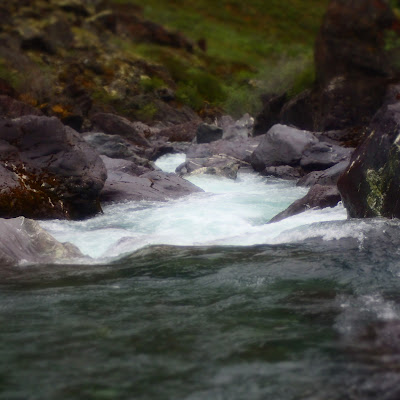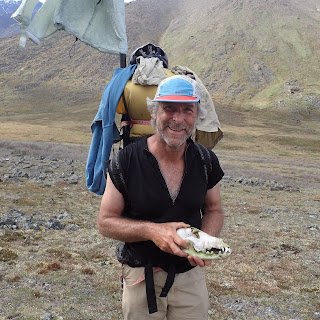The last chapter of our Arctic adventure.....
At this point we had floated the Firth river, hiked up the Malcolm river then and up and over to float down a bit of the Kongakut river, then up out of that and over to the Egakserak, with one more biggish hike to float the Jago not only down to where it flattens out, but also through those flats to the Beaufort Sea (of the Arctic Ocean) and then traverse the coastline to the small, very isolated village of Kaktovik, which has a real airstrip and daily flights back into civilization.
 |
| blue is paddling, red is hiking. The yellow line is the US/Canada border. I was actually geeky enough to ask Roman and Brad if I needed my passport! |
And thus we were back hiking:
 |
| big views |
 |
| Nice flowers |
 |
| and more reminders of the voraciousness of bears; this was earth torn up by a bear looking for a squirrel..... |
 |
| Long descents |
 |
| and more wildlife skulls! (Arctic Fox) |
For a half a day we traversed the far northern edge of the Brooks Range, along a section I called God's Pump Track
Roman appears to be holding onto his hat for the wind, but he actually just saw a falcon drill a big golden eagle and almost knock it out of the sky!
 |
| Kind of a weird photo, but this is a wolf shit that somehow ended up in a willow bush....fairly high! Big Badass Wolf. |
 |
| More nice camping |
 |
| Brad has tramped all over the Arctic Refuge |
 |
| and more big hiking. |
The plains out to the ocean are the controversial part that supposedly are the Saudi Arabia of the north with potential oil.
Apparently Sec of the Interior Zinke just requested yet another review of this area for potential drilling; that's the bad news, and the good news is that these reviews typically take years to execute.
Finally we came to the Jago Valley. The Jago is glacial-fed, so we knew there'd be floatable flows
I put on my dry top:
 |
| I'd blown the neck gasket on the first day, so I put a nice long Titan strap on as my warm dog collar |
And off we went down the river
The nature of these arctic rivers is continuous gradient, so we zipped along quite well for a while without having to paddle much
And there were some great examples of permafrost showing on the banks
with plenty of good flowers doing well in the 24 hour sun
 |
| Lupen seems to thrive everywhere; the Wasatch, the desert, and the Arctic! |
 |
| Brad contemplating the entirety of the trip |
 |
| The Jago stretching towards the mountains |
As we approached the Jago delta the temps plunged with the effect of the cold ocean and the wind started to pick up also, and we were a little worried about getting stuck in the braids. But we found a quick exit before the braids got big and only had to portage about a half mile:
Before hitting salt water
Though physically we were pretty much done with the trip, we still had some stress. The stiff wind was blowing out of the east and carried a lot of fog with it, so as we get into the salt water and started traversing along the coast, the waves came up and it was so foggy that we could only see a little ways. And.....though we had left the land of the grizz, we had entered into the new land of the polar bear, which are scarier to me.
 |
| No, I didn't take this pic; it was in the restaurant in Kaktovik. |
 |
| and this is what I imagined we'd look like if we found white fuzzy boy.... |
At one point I was paddling along with the shore as a handrail, and off in the distance I saw a white animal moving, and my heart leapt into my mouth: is that a polar bear? And suddenly.....a seagull took off in flight! Such was our disorientation in the fog.
Since we couldn't see, we were navigating completely by gps, and a phone-based gps at that, and Brad understandably didn't want his phone out as we paddled through choppy sea water. We finally got to a point where we had to leave our land behind and do a fairly big crossing, and all of us found ourselves being really nervous (I think generally I like smaller bodies of water that move, versus big bodies of water that don't). But I asked myself: is this really sketchy? or is it just a perception due to the lack of visibility, the cold, and the open water? I decided that it was more perception than reality and tried to relax, and generally it worked somewhat, though I was relieved when through the mist I saw something that was definitely not natural, even though it looked like huge skyscrapers far off in the distance? As we got closer we realized they were 25 foot high metal grates that I speculated were to keep ice blocks literally at bay from the shore of the village.
 |
| happy to be on land. |
And our reckoning turned out to be perfect, because we landed right in front of the only place in town, the famous Waldo Arms:
 |
| the bus is the airport shuttle |
that had plenty of places to hang your clothes to dry:
 |
| caribou antlers, whale bones... |
and some interesting characters:
 |
| Heimo and Edna have been recently featured on a series called Wild Alaskans. That jacket she's wearing is caribou leather with wolverine fur |
and some impressive prices for their food:
But the kicker was the accommodations: they had an "annex" that was a literally a storage shed with no power or heat and a couple of spring beds stacked high with mattresses:
 |
| Welcome! |
Roman said "They'll give it to us for $125." Wow, I said, seems like a lot, but better than sleeping with the ravenous roaming polar bears! "Each!" Wow, now we are talking about real money! But they have a bit of a regional monopoly, so annexed we did.
We were also surprised to see a couple of other packraft-laden packs on the porch of Waldo Arms when we arrived; it was
Alpacka Raft's co-owner Sarah Tingey and her adventure pard Marlena who had come down the Hula Hula river (the next major drainage to the east) It was great to share tales of adventures with them.
 |
|
I was pretty excited for this trip since it was likely to be unlike any other, and it very much delivered on many fronts. It was an interesting one for me because I usually am at least mildly alpha in my outdoor pursuits that are usually within my sphere of experience, but being with these two Alaskan/Arctic vets I was very much beta boy; they didn't ask me my opinions on anything, because my opinion didn't much matter and would likely be wrong anyway! But they were very gracious "hosts" and I was able to learn a lot from watching Roman and Brad travel in this unique environment, and for being in close quarters for two weeks they are great guys to travel with; interesting, funny, smart, and as full of fun stories as anyone. I can't thank them enough for their willingness to take a chance on an arctic newbie!























































